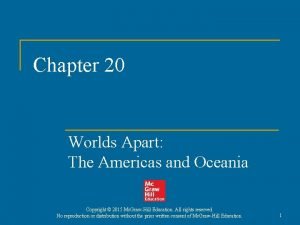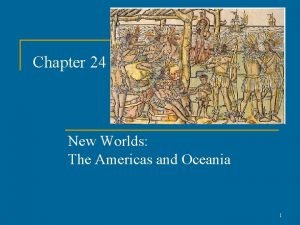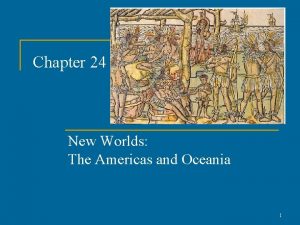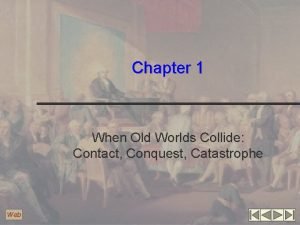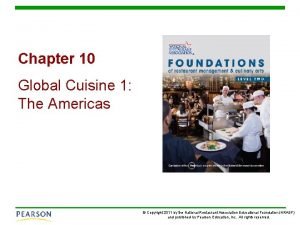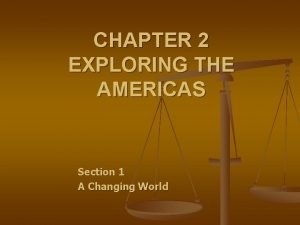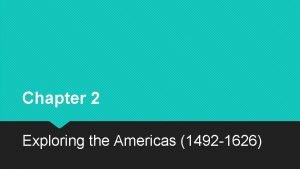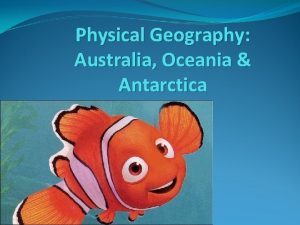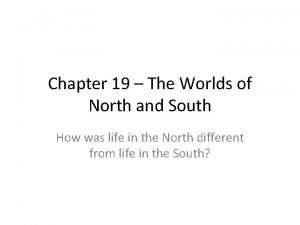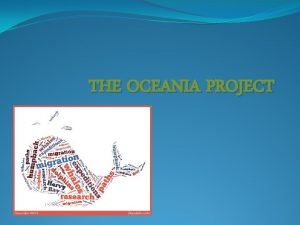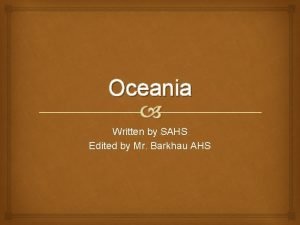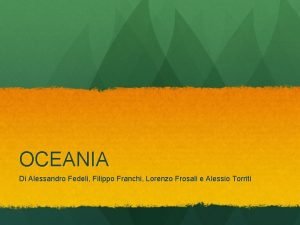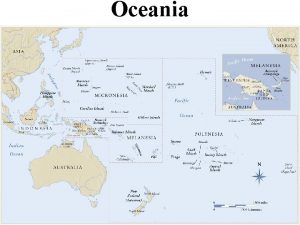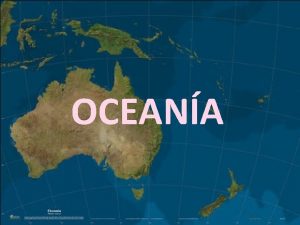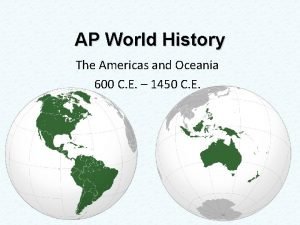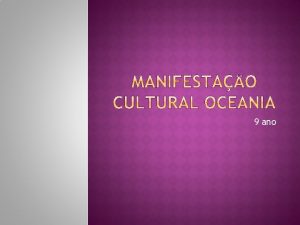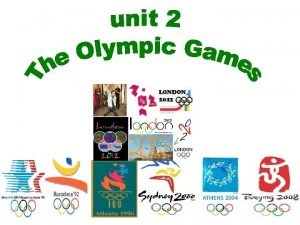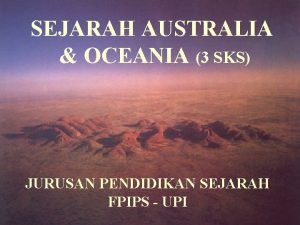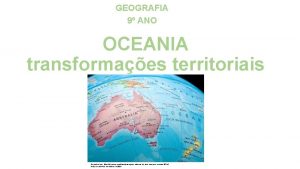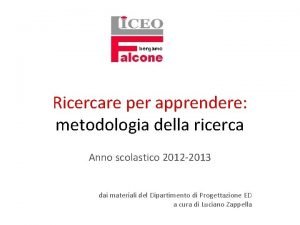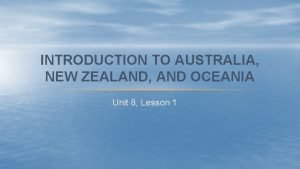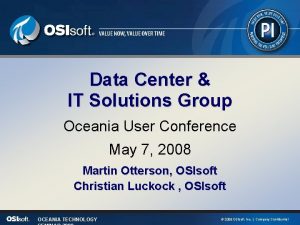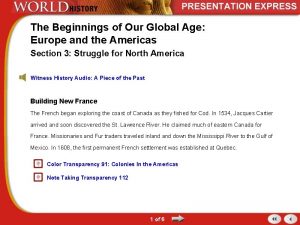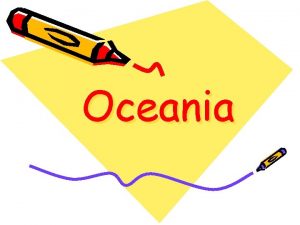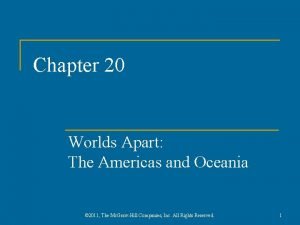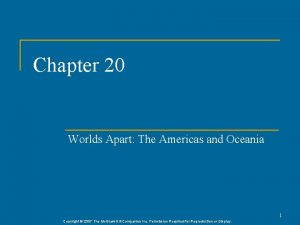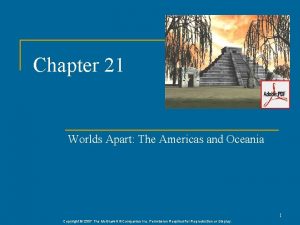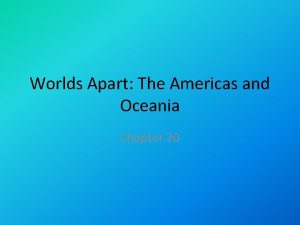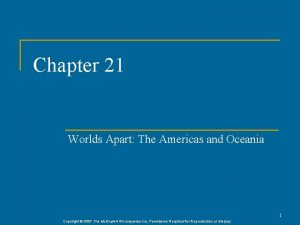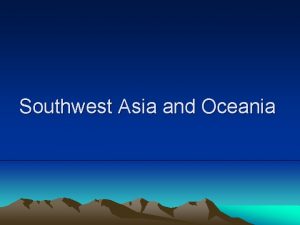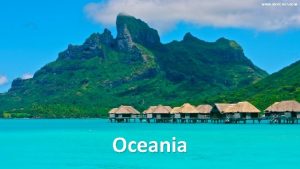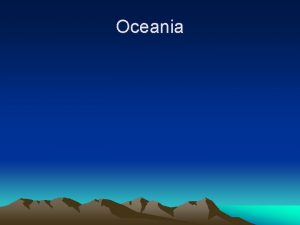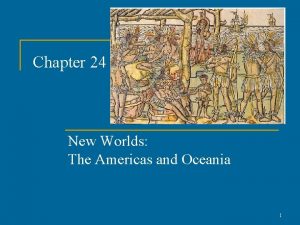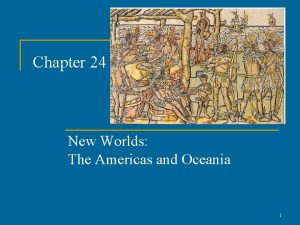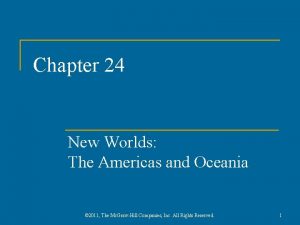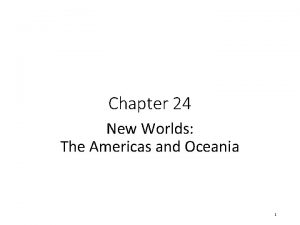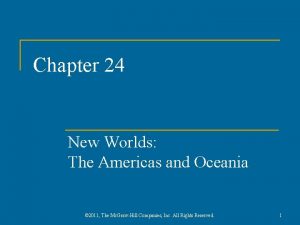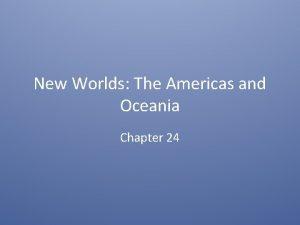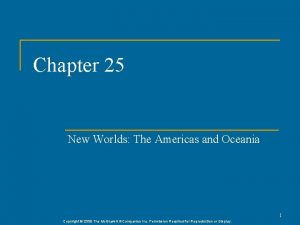Chapter 20 Worlds Apart The Americas and Oceania

































- Slides: 33

Chapter 20 Worlds Apart: The Americas and Oceania Copyright © 2015 Mc. Graw-Hill Education. All rights reserved. No reproduction or distribution without the prior written consent of Mc. Graw-Hill Education. 1

States and Empires in Mesoamerica and North America n Limited or no contact with Africa, Asia, Europe q q n n Brief presence of Scandinavians in Newfoundland, Canada Some Asian contact with Australia Mesoamerica in period of war and conquest, eighth century C. E. Regional states dominated central valley of Mexico Copyright © 2015 Mc. Graw-Hill Education. All rights reserved. No reproduction or distribution without the prior written consent of Mc. Graw-Hill Education. 2

Toltecs n Migration from northwest Mexico q q n Settled at Tula (near modern Mexico city) High point of civilization: 950– 1150 C. E. Urban population of 60, 000; another 60, 000 in surrounding area Subjugation of surrounding peoples Civilization destroyed by internal strife, nomadic incursions, 1175 C. E. Copyright © 2015 Mc. Graw-Hill Education. All rights reserved. No reproduction or distribution without the prior written consent of Mc. Graw-Hill Education. 3

The Mexica n n One of several groups of migrants, mid-thirteenth century C. E. Tradition of kidnapping women, seizing cultivated lands Settled ca. 1345 C. E. in Tenochtitlan (later became Mexico City) Dredged soil from lake bottom to create fertile plots of land q Chinampas, up to seven crops per year Copyright © 2015 Mc. Graw-Hill Education. All rights reserved. No reproduction or distribution without the prior written consent of Mc. Graw-Hill Education. 4

The Aztec Empire n n n Mexica developed tributary empire by fifteenth century Itzcóatl (1428– 1440) Motecuzoma I (1440– 1469) q n Also known as Moctezuma or Montezuma Joined with Texcoco and Tlacopan to create Aztec empire Copyright © 2015 Mc. Graw-Hill Education. All rights reserved. No reproduction or distribution without the prior written consent of Mc. Graw-Hill Education. 5

The Toltec and Aztec Empires, 950– 1520 C. E. Copyright © 2015 Mc. Graw-Hill Education. All rights reserved. No reproduction or distribution without the prior written consent of Mc. Graw-Hill Education. 6

Mexica Society n n Hierarchical social structure High stature for soldiers q q q Mainly drawn from aristocratic class Land grants, food privileges Sumptuary privileges, personal adornment Copyright © 2015 Mc. Graw-Hill Education. All rights reserved. No reproduction or distribution without the prior written consent of Mc. Graw-Hill Education. 7

Mexica Women n n Patriarchal structure Emphasis on child-bearing q q Especially future soldiers Mothers of warriors especially lauded Copyright © 2015 Mc. Graw-Hill Education. All rights reserved. No reproduction or distribution without the prior written consent of Mc. Graw-Hill Education. 8

Priests n n Masters of complex agricultural/ritual calendars Ritual functions Read omens, advised rulers Occasionally became rulers as well Copyright © 2015 Mc. Graw-Hill Education. All rights reserved. No reproduction or distribution without the prior written consent of Mc. Graw-Hill Education. 9

Cultivators and Slaves n Communal groups: calpulli q q q n Originally kin-based Management of communal lands Work obligation on aristocratic lands Slave class q q Debtors Children sold into slavery Copyright © 2015 Mc. Graw-Hill Education. All rights reserved. No reproduction or distribution without the prior written consent of Mc. Graw-Hill Education. 10

Artisans and Merchants n n n Gold, silver, cotton textiles, tropical bird feathers, other items Skilled artisans enjoyed considerable prestige More tenuous position held by merchants in longdistance trade q q Provided exotic products, political and military intelligence Often fell under suspicion Copyright © 2015 Mc. Graw-Hill Education. All rights reserved. No reproduction or distribution without the prior written consent of Mc. Graw-Hill Education. 11

Mexica Religion n Influenced by indigenous traditions from Olmec period Ritual ball game Solar year (365 days) and ritual year (260 days) q Not as elaborate as Maya calendar Copyright © 2015 Mc. Graw-Hill Education. All rights reserved. No reproduction or distribution without the prior written consent of Mc. Graw-Hill Education. 12

Mexica Gods n Tezcatlipoca (“the Smoking Mirror”) q q n Quetzalcóatl (“the Feathered Serpent”) q n Powerful god of life and death Patron god of warriors Arts, crafts, agriculture Huitzilopochtli q q Popular in fourteenth-century; patron of Mexica Emphasis on blood sacrifices Copyright © 2015 Mc. Graw-Hill Education. All rights reserved. No reproduction or distribution without the prior written consent of Mc. Graw-Hill Education. 13

Ritual Bloodletting n n More emphasis on human sacrifice than predecessor cultures Sacrificial victims had tips of fingers torn off before death, ritual wounds q n Victims: Mexica criminals, captured enemy soldiers Personal rituals: piercing of penis, earlobes Copyright © 2015 Mc. Graw-Hill Education. All rights reserved. No reproduction or distribution without the prior written consent of Mc. Graw-Hill Education. 14

Peoples and Societies of North America n Pueblo and Navajo societies q q q n n American southwest Maize farming provided 80% of diet By 700 C. E. , construction of permanent stone or adobe dwellings; 125 sites discovered Iroquois peoples, woodlands east of Mississippi Mound-building peoples q q Ceremonial platforms, homes, burial grounds Cahokia: large mound near East St. Louis, 900– 1250 Copyright © 2015 Mc. Graw-Hill Education. All rights reserved. No reproduction or distribution without the prior written consent of Mc. Graw-Hill Education. 15

Trade n n n No written documents survive regarding northern cultures Archaeological evidence indicates widespread trade River routes exploited Copyright © 2015 Mc. Graw-Hill Education. All rights reserved. No reproduction or distribution without the prior written consent of Mc. Graw-Hill Education. 16

States and Empires in South America n No writing before arrival of Spaniards, sixteenth century C. E. q n n Unlike Mesoamerican cultures, writing from fifth century C. E. Archaeological evidence reveals Andean society from first millennium B. C. E. Development of cities 1000– 1500 C. E. Copyright © 2015 Mc. Graw-Hill Education. All rights reserved. No reproduction or distribution without the prior written consent of Mc. Graw-Hill Education. 17

The Coming of the Incas n n After displacement of Chavín and Moche societies, development of autonomous regional states in Andean South America Kingdom of Chucuito q q n Lake Titicaca (border of Peru and Bolivia) Potato cultivation, herding of llamas, alpacas Kingdom of Chimu (Chimor) q q Peruvian coast Capital city Chanchan Copyright © 2015 Mc. Graw-Hill Education. All rights reserved. No reproduction or distribution without the prior written consent of Mc. Graw-Hill Education. 18

The Inca Empire n n From valley of Cuzco Refers to people who spoke Quechua language Settlement around Lake Titicaca mid-thirteenth century Territory expanded under Inca ruler Pachacuti (r. 1438– 1471) q q Modern Peru, parts of Ecuador, Bolivia, Chile, Argentina Population 11. 5 million Copyright © 2015 Mc. Graw-Hill Education. All rights reserved. No reproduction or distribution without the prior written consent of Mc. Graw-Hill Education. 19

The Inca Empire, 1471– 1532 C. E. Copyright © 2015 Mc. Graw-Hill Education. All rights reserved. No reproduction or distribution without the prior written consent of Mc. Graw-Hill Education. 20

Inca Administration and Quipu n n Incas ruled by holding hostages, colonization No writing; used system of cords and knots called quipu q Mnemonic aid Copyright © 2015 Mc. Graw-Hill Education. All rights reserved. No reproduction or distribution without the prior written consent of Mc. Graw-Hill Education. 21

Cuzco n n n Capital of Inca empire Residents high nobility, priests, hostages Gold facings on buildings Copyright © 2015 Mc. Graw-Hill Education. All rights reserved. No reproduction or distribution without the prior written consent of Mc. Graw-Hill Education. 22

Inca Roads n n Massive road-building system Two north-south roads, approximately 10, 000 miles q q n n n Mountain route Coastal route Paved, shaded, wide roads Courier and messenger services Limited long-distance trade, held by government monopoly Copyright © 2015 Mc. Graw-Hill Education. All rights reserved. No reproduction or distribution without the prior written consent of Mc. Graw-Hill Education. 23

Inca Society and Religion n Social elites dominated by infallible king q n Claimed descent from sun Worship of ancestors q q Remains preserved in mummified form Regularly consulted Sacrifices offered Paraded on festive occasions Copyright © 2015 Mc. Graw-Hill Education. All rights reserved. No reproduction or distribution without the prior written consent of Mc. Graw-Hill Education. 24

Aristocrats, Priests, and Peasants n Aristocrats received special privileges q n n Earlobe spools as adornment Priestly class ascetic, celibate Peasants organized into community groups called ayllu q q q Land, tools held communally Mandatory work details on land of aristocrats Public works Copyright © 2015 Mc. Graw-Hill Education. All rights reserved. No reproduction or distribution without the prior written consent of Mc. Graw-Hill Education. 25

Inca Gods and Moral Thought n n n Inti sun god Viracocha creator god Temples as pilgrimage sites Peasant sacrifices, usually of produce and animals (not humans) Sin understood as disruption of divine order Copyright © 2015 Mc. Graw-Hill Education. All rights reserved. No reproduction or distribution without the prior written consent of Mc. Graw-Hill Education. 26

The Societies of Oceania n Nomadic foragers of Australia q q n New Guinea q n Virtually static culture No agriculture Swine herding, root cultivation ca. 5000 B. C. E. Small-scale trade of surplus food, some goods q Pearly oyster shells, spears, boomerangs Copyright © 2015 Mc. Graw-Hill Education. All rights reserved. No reproduction or distribution without the prior written consent of Mc. Graw-Hill Education. 27

Cultural and Religious Traditions n n n Loosely tied to environment Myths, stories about geological features Rituals to ensure continuing food supply Copyright © 2015 Mc. Graw-Hill Education. All rights reserved. No reproduction or distribution without the prior written consent of Mc. Graw-Hill Education. 28

The Societies of Oceania Copyright © 2015 Mc. Graw-Hill Education. All rights reserved. No reproduction or distribution without the prior written consent of Mc. Graw-Hill Education. 29

The Development of Pacific Island Societies n n n Established in almost all islands in early centuries B. C. E. Trade between island groups Long-distance voyaging on intermittent basis q q Brought sweet potatoes from South America ca. 300 C. E. Voyages preserved in oral traditions Copyright © 2015 Mc. Graw-Hill Education. All rights reserved. No reproduction or distribution without the prior written consent of Mc. Graw-Hill Education. 30

Population Growth n n Extensive cultivation Fishing innovations q n n Fishponds allowed small fish through, trapped larger fish Population density led to social strife, economic degradation Fierce fighting, cannibalism, ca. 1500 Copyright © 2015 Mc. Graw-Hill Education. All rights reserved. No reproduction or distribution without the prior written consent of Mc. Graw-Hill Education. 31

Development of Social Classes n Complexity of population led to articulation of distinct classes q n High chiefs, lesser chiefs, commoners, artisans, peasants Formation of small multi-island empires q q Limited before nineteenth century Yet controlled land allocation, labor and military conscription Copyright © 2015 Mc. Graw-Hill Education. All rights reserved. No reproduction or distribution without the prior written consent of Mc. Graw-Hill Education. 32

Polynesian Religion n Priests as intermediaries to divine Gods of war, agriculture most prominent Ceremonial precinct or temple: marae (heiau in Hawaiian) Copyright © 2015 Mc. Graw-Hill Education. All rights reserved. No reproduction or distribution without the prior written consent of Mc. Graw-Hill Education. 33
 Chapter 20 the americas and oceania
Chapter 20 the americas and oceania New worlds the americas and oceania
New worlds the americas and oceania Chapter 24 new worlds the americas and oceania
Chapter 24 new worlds the americas and oceania Chapter 24 new worlds the americas and oceania
Chapter 24 new worlds the americas and oceania Worlds together worlds apart 4th edition
Worlds together worlds apart 4th edition Worlds apart conquest
Worlds apart conquest Chapter 16 people and empires in the americas
Chapter 16 people and empires in the americas Chapter 10 global cuisine 1 the americas
Chapter 10 global cuisine 1 the americas Chapter 2 exploring the americas study guide
Chapter 2 exploring the americas study guide Chapter 2 exploring the americas answer key
Chapter 2 exploring the americas answer key Oceania history and culture
Oceania history and culture Australia oceania and antarctica
Australia oceania and antarctica Colonial encounters in asia africa and oceania
Colonial encounters in asia africa and oceania Chapter 19 the worlds of north and south answer key
Chapter 19 the worlds of north and south answer key Oceania project
Oceania project What is oceania
What is oceania Settore primario oceania
Settore primario oceania Oceania 1
Oceania 1 Continente insular
Continente insular Oceania in 1984
Oceania in 1984 Physical features of oceania
Physical features of oceania Oceania ap world history
Oceania ap world history Danças típicas da oceania
Danças típicas da oceania London, airstrip one, oceania
London, airstrip one, oceania Asia olympic flag
Asia olympic flag Why are parents in oceania often afraid
Why are parents in oceania often afraid Sejarah australia dan oceania
Sejarah australia dan oceania Slides sobre a oceania 9 ano
Slides sobre a oceania 9 ano Relieve de oceanía
Relieve de oceanía Sitografia come si scrive
Sitografia come si scrive Lesson 1 physical geography of australia and new zealand
Lesson 1 physical geography of australia and new zealand The oceania project
The oceania project Oceania solutions group
Oceania solutions group The beginnings of our global age europe and the americas
The beginnings of our global age europe and the americas
